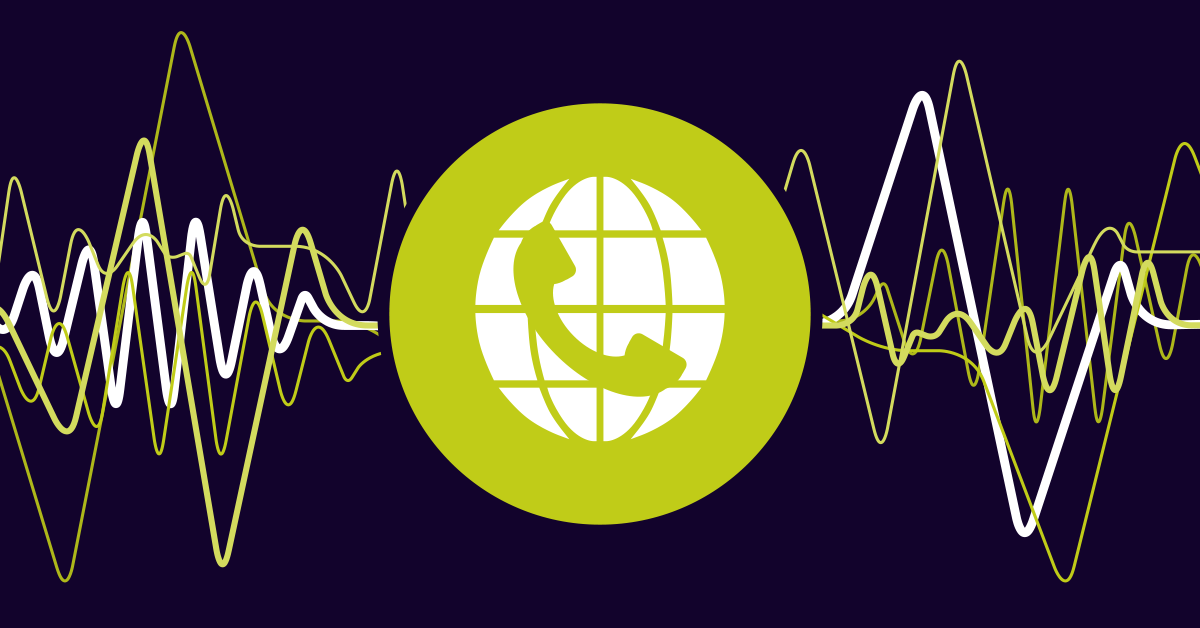Network administrators and IT managers need to understand Mean Opinion Score metrics to ensure optimal VoIP communication quality. A poor MOS value can indicate network problems like high network latency, jitter, or packet loss that directly impact business communications, customer experience, and end-user satisfaction in contact center and telephony environments.
Maybe you haven't considered your network's Mean Opinion Score yet. If you already have a Voice over Internet Protocol PBX or contact center infrastructure, you should monitor the MOS value to ensure high-quality voice calls and optimal audio quality for your end-users.
What Is MOS Score? Understanding Mean Opinion Score for VoIP Networks
The Mean Opinion Score (MOS) has been introduced to provide quantitative assessment of the quality of VoIP communications. Wikipedia defines the MOS score as follows:
Mean opinion score (MOS) is a measure used in the domain of Quality of Experience and telecommunications engineering, representing overall quality of a stimulus or system. It is the arithmetic mean over all individual values on a predefined scale that a subject assigns to his opinion of the performance of a system quality. Such ratings are usually gathered in a subjective quality evaluation test, but they can also be algorithmically estimated using objective measurement algorithms that analyze voice signal characteristics and network conditions.
MOS is a commonly used measure for video, audio, and audiovisual quality evaluation, but not restricted to those modalities. ITU-T has defined several ways of referring to a MOS in Recommendation P.800.1, depending on whether the score was obtained from audiovisual, conversational, listening, talking, or video quality tests. (Wikipedia)
How to Measure MOS Score: VoIP Quality Assessment Methods
Basically, the MOS score is somewhere between the values of 1 and 5. A MOS value of 5.0 certifies excellent quality for voice calls. As a comparison: Public Switched Telephone Network (PSTN) telephony achieves a high MOS between 4 and 5, where 5 represents the absolute optimum case for perceived quality and quality of experience.
The following table provides an initial overview of the different quality levels of the Mean Opinion Score:
| MOS | Quality | Impairment |
|---|---|---|
| 5 | Excellent | No effort required to understand |
| 4 | Good | Slight effort required to understand |
| 3 | Fair | Moderate effort required to understand |
| 2 | Poor | Considerable effort required to understand |
| 1 | Bad | Despite great effort, impossible to understand |
VoIP MOS measurements vary in precision. Human-based assessments typically provide scores to one decimal place. Specialized VoIP monitoring equipment and software can deliver more precise measurements up to 2-3 decimal places, enabling better troubleshooting and network optimization. MOS testing can be affected by various factors including codecs, bandwidth usage, and routing configurations.
Network Quality Monitoring with PRTG Network Monitor
PRTG Network Monitor provides Quality of Service (QoS) monitoring through specialized QoS sensors that measure the network performance metrics affecting VoIP call quality in real-time across data centers and enterprise networks. The QoS (Quality of Service) Round Trip sensor measures critical network performance metrics including jitter, packet loss, and round-trip time that directly impact voice quality and audio quality for voice packets traveling end-to-end through your network infrastructure.
Important Performance Note: QoS sensors have high performance impact. PRTG recommends using no more than 200 QoS sensors per probe to maintain optimal monitoring performance.
QoS Round Trip Sensor Channels
PRTG's QoS Round Trip sensor provides these specific measurement channels:
- Jitter: Average, Maximum, and Minimum values
- Packet Delay Variation: Average, Maximum, and Minimum values
- Packet Loss Metrics: Corrupted (%), Duplicated (%), Lost (%), Out of Order (%)
- Round Trip Time (RTT): Average, Maximum, and Minimum values
- Time to Last Packet: Network response timing
Cisco IP SLA Integration
The Cisco IP SLA sensor monitors Voice over IP (VoIP) network parameters using IP service level agreements (SLA) from Cisco routers and network devices via SNMP. This integration provides enterprise-grade VoIP monitoring capabilities for Cisco network environments, enabling service providers to track voice signal quality across their telecommunications infrastructure.
Key PRTG Features for VoIP Quality Monitoring:
- Real-time QoS parameter tracking (jitter, network latency, packet loss) for voice calls
- Historical trend analysis for network quality patterns
- Correlation with broader network performance metrics
- Customizable dashboards and reporting capabilities
- SNMP-based monitoring of Cisco IP SLA operations
- Support for both remote probe-based and reflector-based monitoring
Ready to monitor your network's VoIP quality parameters with PRTG? Start your PRTG trial and gain visibility into the network factors that affect your voice communications.
Common MOS Score Problems and Network Issues
Network problems that commonly affect MOS scores include:
- High Latency: Round-trip delays above 150ms significantly impact voice quality
- Packet Loss: Even 1% packet loss can degrade MOS scores noticeably
- Network Jitter: Inconsistent packet arrival times create choppy audio
- Bandwidth Congestion: Insufficient bandwidth allocation for voice traffic
- Network Device Misconfigurations: Improperly configured QoS policies
Monitoring these factors provides complete end-to-end visibility into VoIP performance issues and quality degradation. Professional network monitoring helps identify root causes before they impact business communications and customer experience in contact center and telephony operations.
MOS Score vs Other VoIP Metrics
While MOS value provides an overall quality assessment for voice calls, comprehensive VoIP monitoring requires tracking additional telecommunications metrics:
- R-Factor: The underlying calculation that determines MOS scores
- RTCP Statistics: Real-time control protocol data for active calls
- Call Detail Records (CDR): Historical call quality and termination data
- Jitter Buffer Performance: How well your system handles variable packet timing
PRTG's advantage lies in correlating QoS parameters (jitter, network latency, packet loss) with broader network performance metrics, helping you identify root causes rather than just symptoms. This integrated approach provides comprehensive network visibility beyond isolated voice quality monitoring, enabling you to optimize network conditions for high-quality voice communications across your entire infrastructure.
Best Practices for Improving Your Network's MOS Score
Implement Proper QoS Policies
Prioritize voice traffic over less critical data to ensure consistent call quality. Configure traffic shaping and bandwidth allocation specifically for VoIP applications.
Monitor Network Performance Continuously
Use automated network monitoring tools to track network latency, jitter, and packet loss in real-time. Set up proactive alerts to address network conditions before they affect call quality and create quality degradation for end-users.
Optimize Network Infrastructure
- Ensure adequate bandwidth for voice traffic
- Minimize network hops between voice endpoints
- Use dedicated voice VLANs where possible
- Regularly update network equipment firmware
Regular Performance Assessment
Conduct periodic MOS testing assessments across different network paths and times of day to identify patterns and potential improvements in voice signal quality.
"Poor voice quality costs businesses an average of 30% longer phone call times and significantly impacts customer experience in contact centers. Proactive network monitoring prevents these costly communication breakdowns and maintains high-quality voice calls for improved user experience."
Business Impact of Network Quality Monitoring
For Network Engineers
QoS parameter monitoring provides immediate feedback on network changes and helps troubleshoot VoIP issues faster. Real-time alerting on jitter, latency, and packet loss enables proactive problem resolution before users experience call quality problems.
For IT Managers
Executive dashboards showing network quality trends help demonstrate IT performance to business stakeholders. Historical QoS metrics support infrastructure investment decisions and capacity planning for telecommunications and data center environments.
Return on Investment
- Reduced help desk tickets related to voice quality
- Improved customer satisfaction and shorter call resolution times
- Prevented business disruptions from communication failures
- Better resource allocation based on actual usage patterns
Conclusion: Take Control of Your VoIP Quality
Understanding and monitoring MOS values is essential for maintaining professional communication standards in today's business environment. With the right network monitoring tools and best practices, you can ensure consistently high-quality voice calls and excellent quality user experience that supports your organization's productivity, customer experience, and telephony objectives.
Discover how PRTG's QoS monitoring can help you track the network performance metrics that affect audio quality and voice signal integrity across your entire telecommunications infrastructure, from data centers to end-user devices. Download PRTG free trial and see the difference professional network monitoring makes.
 Published by
Published by 




.jpg)






